Team 21: Romuald Thomas, Catherine Qing, Karina Li, David Kwoba
Assumption # 1
Overview
For our first assumption, we wanted to examine the frequency in which users engaged with stretching suggestions offered through scheduled reminders. Moreover, our team wanted to test the idea whether the presentation of a wide range of various stretch suggestions was more effective in maintaining user engagement or would users prefer to consistently receive similar suggestions with less variance.
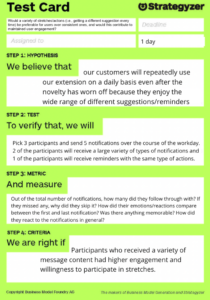
Experiment Design
To test our assumption, our team gathered 3 participants and over a span of a day, sent 5 reminder notifications at scheduled time intervals. To test the idea as to whether users preferred a variety of messages or similar messages with consistent suggestions, we sent 2 participants a large variety of reminders with different stretching activities, and 1 participant reminders with the same type of stretching activities. To learn more about the experimentation process of our assumption test, please refer to this blog post!
Participants
For this assumption test, our team recruited 3 participants who identified themselves to be students. Moreover, our team wanted to gather individuals who fit one of our main target demographics – individuals who are likely to sit for prolonged periods of time consistently each week, and susceptible to harms caused by sedentary behavior. We believe that college students fit this description quite well and given our proximity to a major university, they turned out to be perfect candidates for our test.
Artifacts
After our team completed testing, we collected the sentiments expressed by our participants as well as the frequency of suggestions that were followed over the course of a day. Collectively we found that most participants followed through with most suggestions with one participant completing 80% of suggested stretching activities.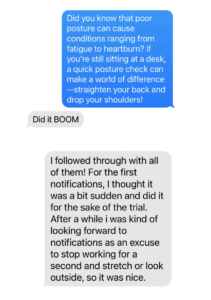
To gage sentiment, some questions we asked participants include the following:
- How did your emotions/reactions compare between the first and last notification?
- Was there anything memorable about the notifications you saw?
- How did you generally react when you saw the notification?
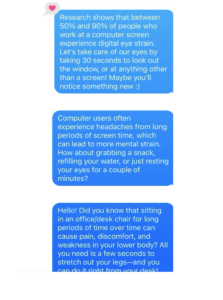
By asking these questions, our team was able to collect general sentiments regarding the receival of reminder messages, enabling our team to discern the effectiveness of sending various suggestions or consistent ones.
Final Synthesis
After the assumption test, it was found that users were more receptive to suggestions that offered a variety of activities to practice, with diverse reminders having the highest retention rate in terms of engagement. In addition, through gathering user sentiments it was found that the novelty of each message evoked some feelings of excitement as users tended to enjoy the new reminders and looked forward to them.
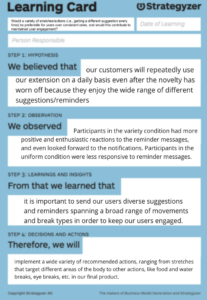
Assumption #2
Overview
For our second assumption, our team wanted to examine the effect that the inclusion of friends impacted user engagement with our application. In accordance, our team tested whether sharing progress with friends would motivate users to take more breaks and engage with stretching suggestions, creating a supportive social environment where users can seek improvement in their daily sedentary habits.
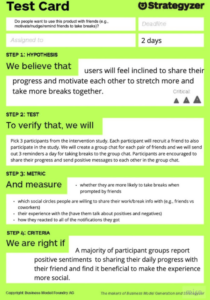
Experiment Design
To test our assumption, our team gathered 3 participants and had each participant recruit a friend of theirs. Afterwards, a group chat for each participant and their friend was created and monitored by a team member. Over the course of two days, participants within each group chat were encouraged to send encouraging messages with one another, including positive or negative reactions and at the end, a description of their overall experience. To learn more about how this experiment was conducted, please refer to this blog post!
Participants
For our assumption test, our team recruited 3 participants where 2 identified themselves as students and 1 as a full-time worker. Following our team’s goal of gathering individuals who are likely to spend prolonged periods of time sitting down on a computer, in addition to students, our team felt that full time office workers also met this criteria and thought it would be beneficial to include this group within our assumption tests. Along with the initial 3 participants, we also had each individual recruit a friend that they would like to send messages to, and all of them identified themselves to be students as well.
Artifacts
After testing our assumption, our team collected overall sentiments expressed by participants by brief post-interviews as well as measuring the frequency in which users engaged with the daily reminders that they received. For one group, through the inclusion of a friend it was found that users adhered to ⅔ of messages that were received and for another group, users engaged with all messages that were sent.
Some questions that our team asked to gage sentiment include the following:
- How did you generally react when you saw notifications from the group chat?
- How would you describe your experience with this activity? Feel free to talk about what you liked and/or disliked.
- Which social circles are you willing to share your work/break info with?
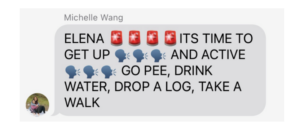
Final Synthesis
Overall, it was found that users were more receptive to messages that were sent by friends; however, this only seemed to work in instances where the user and friend were particularly close with one another. Through post interviews, participants expressed that through the inclusion of reminders within a social space, they felt more motivated to engage with stretching activities and in some cases, encouraged to continue as it provided a medium for them to connect with their friends. This was not the case for all participants however, as some expressed that they would prefer to receive suggestions on an individual basis.
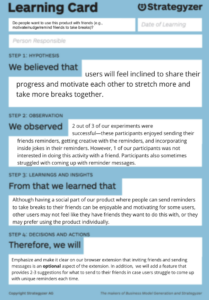




Comments
Comments are closed.